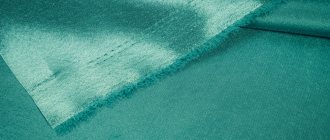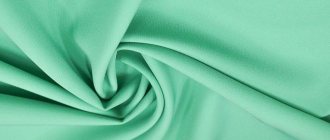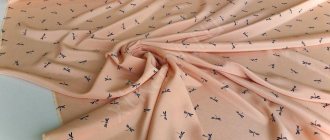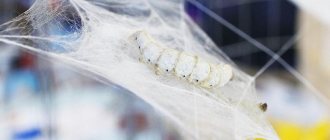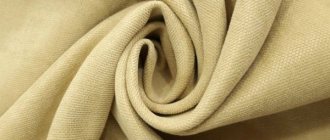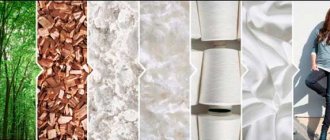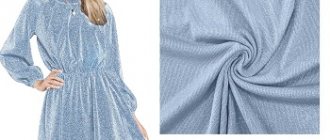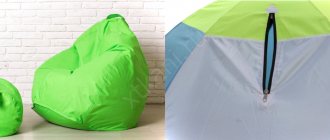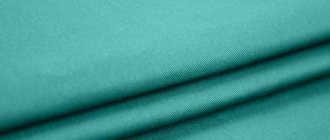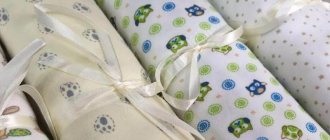Polyester silk, polyester , microfiber , acrylic - this is not a complete list of names of fabrics based on polyester fiber . All of them are of artificial origin, but this does not make their popularity less, but rather increasing.
Polyester fabric is one of the most promising, popular and widespread materials used in modern light industry.
A wide variety of objects and things are made from polyester fabrics - from suspended ceilings, ropes, tents to all kinds of banners and flags. These types of fabrics are used as lining material for outerwear, as well as for sewing blankets and pillows. In addition, the material is used in combination with natural fibers in the manufacture of home textiles (linen), which gives the latter strength and, accordingly, extends its service life.
Polyester fabric is a man-made material made from polyester fibers.
What type of fabric is this
Polyester fabrics are synthetic materials made from polyester (PE) fibers. Polyesters occur naturally. Wood resins, amber are natural polyesters. Synthetic species are a broad class of polymers obtained by synthesis from polybasic acids and polyhydric alcohols.
Polyester fabric colors
PEF fibers are made at textile factories from melts of synthetic polyesters - polyethylene terephthalate and its derivatives. On spinning machines, the molten raw material is forced through the holes of the spinnerets. The flowing streams harden in the cold air, forming fine fibers. The primary threads are drawn, heat set and finished.
Polyester fabrics are made from yarn on weaving machines. Other chemical and natural fibers are often added to polyesters. They produce dense shiny or matte materials that are similar to silk, wool, and cotton.
What is the reason for the high popularity of the material?
Its popularity is due to the fact that polyester fiber, obtained from an alloy of polyethylene terephthalate, has unique chemical properties that impart excellent physical properties to the fabric produced on its basis. Indirect evidence of this is provided by materials that, along with fabric, are made from polyester fibers. Among them are faux fur , insulation materials, and material for tire reinforcement. However, a description of the properties of the polyester fabrics themselves is much more revealing.
First of all, polyester fabric is durable and abrasion resistant . It is surprisingly heat-resistant and surpasses most natural and synthetic materials in this indicator. For example, polyester fibers retain 50% strength when heated to a temperature of 180 °C. In addition, they are fireproof and fireproof. This material is difficult to set on fire; it goes out immediately when moving away from the source of fire.
An important quality of polyester is light fastness and water resistance . This explains its suitability for the manufacture of tents, sleeping bags, and outerwear intended for use in wet conditions.
It is very important that the material is resistant to crushing and practically does not lose its shape . It is able to maintain the shape specified during manufacture and hold it even under the influence of high temperatures. In this regard, clothes made of polyester fabrics that have a certain shape (for example, pleated or pleated skirts The popularity of the material is also explained by its wide variety. There is a huge variety of polyester fabrics, each of which has different characteristics in terms of parameters such as density, elongation, etc. Among this variety, polyester silk, polyester , microfiber and acrylic .
Polyester materials have found wide application in various fields of the national economy. They make high-quality suspended ceilings and ropes. They are also indispensable in the manufacture of flags and banners - they can withstand all natural disasters. Blankets, pillows , bed linen , lining in outerwear, dresses , suits and many other things made from them last a long time and do not lose their attractiveness.
Origin story
Synthetic polyester fibers have been produced since the mid-20th century. Trade names of fibers and fabrics made from them are polyester, terylene, dacron, lavsan.
Polyester
Popular synthetic fabric polyester: what is known about its characteristics and areas of application?
more details
Lavsan
Oil fabric lavsan: what is known about it? What are its characteristics?
more details
In England, pilot production of terylene appeared in the late 1940s, industrial production - a few years later. Dacron was released in the USA in 1953.
In the laboratory of the USSR Academy of Sciences, lavsan was synthesized in the late 1940s. The Kurskkhimvolokno chemical enterprise has been producing lavsan in industrial quantities since 1960.
Application in sewing workwear
When sewing workwear, special requirements are placed on fabrics: clothing must be comfortable to wear, last a long time, be easy to care for, have protective properties and be inexpensive.
Very often, material for workwear is treated with various impregnations (water-repellent, acid-proof, heat-resistant) to impart additional properties.
All these requirements are met by mixed materials, such as:
- " Oxford " (a mixture of polyester and nylon) is very often used when sewing workwear. It turns out to be very durable, insensitive to temperatures, resistant to humidity and chemicals. Oxford is used to make summer work suits , as well as insulated suits for cold temperatures.
- Materials such as “ Greta ”, “ Twill ”, “Tomboy” (various ratios of polyester and cotton) are used when sewing clothes for indoor work. The clothes are breathable, but at the same time very dense, tear-resistant, and durable. It can be washed at high temperatures, it protects against dust, and does not require ironing.
- Fabrics such as “Pulse”, “Metelitsa”, “ Panacea ” (a mixture of polyester fibers and viscose) are used to sew clothes that fit well and look elegant. The overalls made from them are intended for medical workers, cooks, flight attendants, and office workers.
Possessing a number of necessary properties, polyester seems to have been created for the manufacture of workwear . What else is polyester used for?
Fabric composition and its properties
The materials consist of synthetic PEF fibers. Fabrics are produced with the addition of other fibers. An example of a composition is polyester with the addition of elastane.
Properties:
Do not collapse due to temperature changes.
Difficult to light. Once the source of ignition is removed, they go out.
Resistant to light and oxygen.
Do not absorb water (except microfiber).
Resistant to moths, mold, microorganisms.
They retain their shape well and do not wrinkle.
Resistant to hydrogen peroxide and not destroyed in organic solvents.
Elastic, with low thermal conductivity.
Durable, abrasion resistant.
Use of polyester (polyester)
When polyester is mixed with other types of fibers, completely new fabrics are obtained that are used for various needs.
- When polyester is mixed with polyamide, a very elastic, wear-resistant material is obtained, similar to silk , which does not deform or lose color during use, but at the same time it electrifies and does not absorb moisture. The resulting fabric is used for sewing women's underwear.
- Polyester with spandex (or elastane) is a very dense, elastic material that stretches well and is breathable. This combination is used for sewing hosiery, gloves, and tracksuits.
- When polyester is added to cotton, a durable and elastic material is obtained with the following advantages: it does not deform, does not fade, lasts a long time, does not wrinkle and dries quickly. At the same time, the quality of cotton is improved and its disadvantages, such as stretching, creasing, and fading, are reduced. Very often, fabric with this composition is used for sewing bed linen, since this combination of fibers produces very high-quality designs and bright colors.
- If polyester threads are added to viscose , the resulting fabric does not fade or lose its shape. It is used to make clothing for work and leisure.
Polyester fiber is mixed with other types of fibers in different proportions, resulting in many types of fabrics with different characteristics. In any case, polyester improves the quality of the fabric, but, like any substance, it has pros and cons.
Polyester in its pure form has sufficient rigidity and, even when deformed, always strives to return to its original shape. As part of other fabrics, polyester fibers impart certain properties to products. For example, they can be found in combination with cotton, linen, natural silk and other fabrics that require improved performance characteristics.
In light industry, polyester fabric is used almost everywhere. The only difference is in its structure and percentage relative to other fibers.
Combination with cotton
It is clear that synthetics in natural fabric slightly reduce its hygienic properties. But it pays off with the following advantages of the cotton-polyester combination:
- The service life of the product increases several times;
- The fabric becomes almost wrinkle-resistant, which is very important for outerwear;
- Production becomes cheaper;
- The fabric is easier to clean and is not so afraid of aggressive chemical compounds.
The lion's share of all the things we wear and use every day are made from this fabric. These are raincoats , blouses, dresses , combinations, suits , sportswear , accessories , etc.
With wool
Adding polyester fibers to wool can increase the service life of the product by 4-6 times. If the fabric contains no more than 30% synthetics, then it is almost no different from pure wool. Clothing and linen made from this textile can be machine washed, wringed and cleaned.
With flax
Premium suits for men and women Sportswear , summer sundresses, shorts , T-shirts and blouses made from linen often contain a small percentage of polyester fibers.
Types of fabric
By production method:
- Non-woven fabrics. Rolled canvases, bonded by needlepunch or thermal methods. Durable, elastic. Suitable for construction, repair, insulation.
- Woven fabrics.
- Knitwear. Knitted from yarn made from PEF staple fibers.
Polyester fabrics:
Polyester, lavsan
Crinkle-resistant, heat-resistant, rigid, do not allow water to pass through.
Made from acrylic fibers
Dense, waterproof, steam permeable
Microfiber
Fibers with a diameter of several microns. Soft, absorb water well.
Polyester silk
Lightweight but durable. Often treated with protective compounds.
Use in other areas
The material reduces the cost of products and makes them accessible to consumers , therefore it is widely used in almost all areas of life:
- most types of everyday clothing are sewn from it (men's shirts , windbreakers, trousers , dresses , underwear, stockings, skirts , socks );
- polyester is indispensable in the manufacture of tracksuits and trousers for cyclists;
- widely used for sewing outerwear ( raincoats , windbreakers, lining for outerwear, coats , jackets , hats );
- home textiles (bed linen, tablecloths, curtains, bedspreads, blankets);
- production of accessories (umbrellas, caps , gloves , bags );
- insulation ( sintepon , holofiber);
- in the manufacture of soft toys;
- hiking accessories ( tents , sleeping bags ).
There is probably not a single person who does not have things at home containing polyester fibers. Very often, between natural and synthetic raw materials, preference is given to synthetics for their properties . Although products made from it are unpretentious to use, there are still some peculiarities in caring for polyester.
Pros and cons of fabric
Advantages of materials:
- resistant to light and temperature changes;
- non-flammable, chemically resistant;
- resistant to mold, moths;
- durable, resistant to bending and abrasion;
- do not wrinkle, keep their shape;
- with low hygroscopicity (a plus for protective coatings);
- thermoplastic, retain the pleated effect;
- lightly soiled, easy to clean;
- easy to wash, dry quickly;
- low prices.
Flaws:
- low hygroscopicity;
- poor hygienic properties;
- become electrified;
- pellets form;
- hard;
- Polyester doesn't dye well.
To eliminate the shortcomings, PEF yarn is combined with elastane, viscose, cotton, silk, and wool.
Rules of care
Now we will answer the questions about whether and how to properly wash polyester items in a washing machine, how to dry and iron them.
Most material is afraid of high temperatures and, if we are talking about washing, then the spin mode. If you adhere to the following recommendations, clothing or other polyester products will last you a long time.
- Both hand and machine wash possible.
- Before washing, carefully read the product tag for care instructions.
- The optimal temperature regime for polyester is +300C+400C, but some fibers feel good at temperatures of +600C. If the water temperature is too high, the product may become severely wrinkled.
- Use a delicate wash cycle, do not spin.
- Do not bleach polyester items, and never boil them.
- Do not use drying chambers or allow polyester to come into direct contact with a radiator or other heat sources. If you want to dry the item in the fresh air, then avoid direct sunlight.
- You can iron the fabric only through gauze, and the iron should be set to the minimum temperature setting.
Rules to follow when leaving:
- Before washing polyester, it is advisable to take into account the manufacturer's information indicated on the tag, which outlines the rules for caring for a specific product.
- Almost all items are machine washable , but some are intended for hand washing only (this information is usually indicated on the tag). When washing by hand, you need to prepare a solution of warm water and washing powder.
- The recommended water temperature for washing clothes is 40 C , unless the item is impregnated with a special composition for washing in hot water. If the temperature conditions during washing are not observed, the product may lose shape.
- When washing, do not use bleach , as it can damage the structure of the item.
- In a washing machine, polyester on a delicate cycle and spin at a speed of no more than 800 rpm .
- Using conditioner when washing makes things soft and reduces electricity.
- Polyester items generally do not need to be ironed; after washing, it is enough to gently straighten them and leave them to dry.
- If ironing is required, then you need to set the temperature to low or in the “ silk ” mode and iron from the wrong side or through a damp cloth.
- If necessary, items can be dry cleaned.
You should not be afraid of its unnaturalness, because technology does not stand still and, perhaps, very soon an ideal synthetic fabric will be created that will not be inferior in its characteristics to natural materials , and even surpass them.
What standards are used in production? What do they take into account?
GOST standards apply for polyester materials:
- 26095-84 - for technical fabrics;
- 25076-81 - for vehicle finishing;
- 29223-91 - for dresses, dresses and suits made of chemical fibers.
State standards set standards for:
- raw materials, dyes;
- physical and mechanical characteristics;
- color fastness;
- deviations in width, surface density;
- grades;
- labeling, packaging;
- test methods, acceptance;
- transportation, storage.
Manufacturing methods
Today, there are three main methods for producing polyester non-woven fiber:
- thermal method
Through heat treatment, raw materials are exposed to high temperature conditions. As a result, some of the fiber elements begin to stick together through melting, forming a single system of especially strong fibers. Note that this method creates a durable holofiber with a high degree of wear resistance and minimal deformation.
- glue method
This method is interesting because the output is a product without any distinctive properties of non-woven holofiber, since its quality characteristics are noticeably lower. It is worth noting that the glue-based mixture in combination with other unnecessary components is washed out over time, however, the original external appearance of the product also disappears.
- needle-punched method
The structure of the padding polyester produced in this way is characterized by increased strength. Using a device consisting of a series of needles, the connection of chemical fibers is achieved. The filler has a fairly low price and excellent thermal insulation properties. The product cannot be used if the temperature is less than 10 degrees.
Reviews
According to statistics of user opinions, it is possible to identify predominantly positive statements, confirmed by photos of products. Budget-friendly, bright, durable, durable and hypoallergenic material is loved by consumers of all ages. The category of outerwear is especially highlighted. Waterproof fabric maintains comfortable conditions even with heavy rainfall and increased dampness on the street.
The concern is the generation of static electricity. If you skip treatment with antistatic agents, you may experience inconvenience.
Note! People who adhered to the rules of care did not observe any negative consequences.
Varieties
Polyester is not the name of any one fabric. This is the name given to a group of canvases obtained in different ways. Due to this, they have slightly different structures and properties.
Polyester
Of all in the polyester group, it is the best dyeable and the most water resistant.
This synthetic material is often used to create fabrics for furniture, baby strollers, various covers and home textiles.
Lavsan
This is a type of polyester. It is popular in the manufacture of textiles for home and office. Curtains and drapes are often made from 100% lavsan.
Acrylic
Has high density. Due to this, it tolerates any climatic conditions. Therefore, acrylic is often used as a raw material for outdoor banners, posters, tents and marquees.
The canvas is also popular in construction. It is popular in the production of wallpaper and suspended ceilings.
Microfiber
The main advantage: it allows air to pass through better than others. Therefore, the fabric is ideal for sports trousers, T-shirts, suits, bed linen
Polyester silk
It is characterized by low density and lightness.
Choosing a polyester fiber pillow
A product made of polyester siliconized fabric can be washed, however, as a result of this, over time it loses its original shape.
If you notice that your pillow has changed shape, has a pungent odor, has lumps, and after sleep you feel headaches or fatigue, then it’s time to buy a new pillow. The product should be selected individually, taking into account the sleeping position, age indicators and physiological characteristics of the person, plus you should pay attention to personal preferences. To support your head in the correct position, you should choose a pillow with a bolster - a special recess for supporting the head. The use of the latest technologies and specialized equipment in the production of products has contributed to the creation of soft and lightweight fillers that are comfortable to sleep on. An acceptable price and environmental friendliness are indicators of high demand among consumers of the product.
